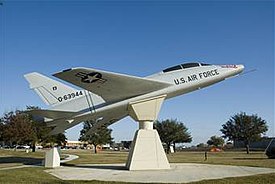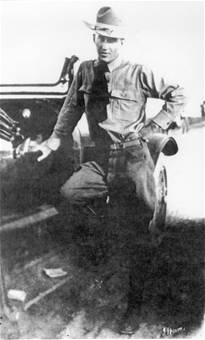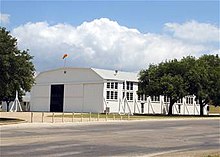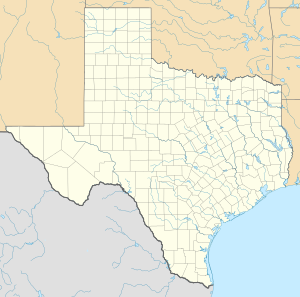Brooks Air Force Base was a United States Air Force facility located in San Antonio, Texas, 7 miles (11 km) southeast of Downtown San Antonio.
| Brooks Air Force Base Brooks Field | |
|---|---|
| Part of Air Force Materiel Command (AFMC) | |
| San Antonio, Texas | |
 | |
| Coordinates | 29°20′24″N 98°26′20″W / 29.340°N 98.439°W |
| Type | Former Air Force Base |
| Site information | |
| Owner | City of San Antonio, Texas |
| Controlled by | |
| Site history | |
| Built | 1918 |
| In use | 1919–2011 |
| Garrison information | |
| Current commander | Eric L. Stephens |
| Garrison | 311th Air Base Group |
| Occupants | USAF, City offices, commercial tenants |


In 2002, Brooks Air Force Base was renamed Brooks City-Base when the property was conveyed to the Brooks Development Authority as part of a project between local, state, and federal government. The Brooks Development Authority is now the owner and operator of the property, and is redeveloping it as a science, business, and technology center; the U.S. Air Force was the largest tenant at Brooks City-Base before the departure of its operations in 2011.[1][2][3]
Units
editMajor units
editTenant units
editHistory
editOn February 16, 1918, Kelly Field No. 5 became a separate post and named Brooks Field by the Aviation Section, U.S. Signal Corps to honor San Antonio aviator Sidney Johnson Brooks, Jr.[4] The first commander of Brooks Field was Lt. Col. H. Conger Pratt, who until the preceding October had been a cavalryman.
From its founding until 1919, Brooks Field was used to train cadets in the Curtiss JN-4 aircraft, which was used for balloon and airship training. The program was cancelled in 1922 when the U.S. Army re-evaluated the usefulness of balloons and airships.
After the cancellation of the airship training, the 11th School Group was formed at Brooks Field as the Primary Flying School for the Air Service and Army Air Corps. The Primary Flying School continued operation until 1931 when it moved to Randolph Field in San Antonio. After the Primary Flying School's departure, Brooks Field became the new home for the Aerial Observation Center.
During World War II, Brooks Field housed the School for Combat Observers and the Advanced Flying School (Observation). The program remained in operation until 1943 when it was disbanded. Training in the school then switched to twin-engine aircraft, subsequently training pilots to fly the B-25 bomber.
After the war, Brooks Field became the home to several tactical and reserve units, and in 1948, Brooks Field formally became Brooks Air Force Base.
Since the early 1950s, Brooks AFB has been the home for the Aerospace Medical Center, which would include the School of Aerospace Medicine (SAM). In 1957, SAM scientists moved into the newly completed center at Brooks AFB. SAM aided the National Aeronautics and Space Administration (NASA) with Project Mercury and served as a back-up site for lunar samples brought back to Earth on the Apollo missions between 1969 and 1972. The air evacuation program at Brooks AFB proved vital to the care of wounded personnel in the Vietnam War.
President John F. Kennedy dedicated the School of Aerospace Medicine on November 21, 1963, the day before he was assassinated in Dallas, Texas. This was Kennedy's last official act as president.[5]
After the Vietnam War, the base's mission narrowed to one centered on specific research related to U.S. Air Force fliers and personnel. In 1991, the Air Force was selected to house the Armstrong Laboratory, which included the Air Force Human Resources Laboratory, the Air Force Drug Testing Laboratory, the Harry G. Armstrong Aerospace Medical Research Laboratory, the Air Force Occupational and Environmental Health Laboratory, and the laboratory functions of SAM.
BRAC
editFollowing the 1995 BRAC, when Brooks AFB was removed from the Base Realignment and Closure list, city, state, military, and community planners began several years of hard work to develop a plan to privatize approved the gradual transition in ownership of Brooks AFB from the Air Force to the Brooks Development Authority. This transition came into full effect on July 22, 2002, when the Brooks Development Authority assumed control of the newly named Brooks City-Base.
In 2005, Brooks City-Base was once again placed on the BRAC list. Air Force operations ceased on 15 September 2011. The Brooks Development Authority has demonstrated economic development success with projects including a 62-acre (250,000 m2) retail development, approximately 256,000 square feet (23,800 m2) of research and distribution facilities for DPT Laboratories, the South Texas Center for Emerging Infectious Diseases (an infectious disease research institute coordinated with the University of Texas at San Antonio), an international pharmaceutical company, and a $25.5 million City/County emergency operations center which opened in the Fall 2007. Brooks City-Base inactivated the 311th Air Base Group on 1 Sept, 2011, and the remaining few USAF personnel had shuttered the base for good by the 15th of that month.
Historic Hangar 9
editBrooks Field Hangar 9 was restored in 1969 to become the U.S. Air Force Museum of Aerospace Medicine. This museum is to display the early history of Brooks Field and to preserve and display an extensive collection of photographs and equipment related to aviation and aerospace medicine.[6][7]
Previous names
edit- Gosport Field, prior to December 5, 1917
- Signal Corps Aviation School, Kelly Field #5, December 5, 1917
Major commands
edit|
USAAC/USAAF
|
United States Air Force
|
Base operating units
edit|
USAAS/USAAC/USAAF
|
United States Air Force
|
Government and infrastructure
editThe United States Postal Service Post Office at 8060 Aeromedical Road closed in late May 2011.[8]
See also
editReferences
edit- ^ William R. Evinger: Directory of Military Bases in the U.S., Oryx Press, Phoenix, Ariz., 1991, p. 147.
- ^ World War I Group, Historical Division, Special Staff, United States Army, Order of Battle of the United States Land Forces in the World War (1917–1919)
- ^ Evinger, 1991; the name was derived from the flight instruction system in use at the time at the field.
- ^ Evinger, 1991.
- ^ "historicaldocuments.com". Archived from the original on 2009-03-01. Retrieved 2007-02-22.
- ^ Natl Park Service: USAF Museum of Aerospace Medicine
- ^ USAF Museum of Aerospace - Hangar 9 Archived 2011-06-08 at the Wayback Machine Military site.
- ^ "Post Office Location - BROOKS AFB[permanent dead link]." United States Postal Service. Retrieved on April 16, 2009.
Sources
edit- Mueller, Robert (1989). Active Air Force Bases Within the United States of America on 17 September 1982. USAF Reference Series, Maxwell AFB, Alabama: Office of Air Force History. ISBN 0-912799-53-6
- Maurer, Maurer (1983). Air Force Combat Units Of World War II. Maxwell AFB, Alabama: Office of Air Force History. ISBN 0-89201-092-4.
- Mauer, Mauer (1969), Combat Squadrons of the Air Force, World War II, Air Force Historical Studies Office, Maxwell AFB, Alabama. ISBN 0-89201-097-5
- Shaw, Frederick J. (2004), Locating Air Force Base Sites History's Legacy, Air Force History and Museums Program, United States Air Force, Washington DC, 2004.
- This article incorporates text from this source, which is in the public domain: Brooks City-Base
- This article incorporates public domain material from the Air Force Historical Research Agency
External links
edit- USAF Brooks City-Base Archived 2007-01-19 at the Wayback Machine (official site)
- Brooks City-Base / Brooks Development Authority (official site)
- U.S. Air Force School of Aerospace Medicine (USAFSAM) Archived 2007-12-25 at the Wayback Machine
- Brooks City-Base at GlobalSecurity.org
- Aviation: From Sand Dunes to Sonic Booms, a National Park Service Discover Our Shared Heritage Travel Itinerary
- Google Map of Brooks City-Base
- http://www.mysanantonio.com/news/military/article/Air-Force-era-at-Brooks-ends-2150025.php

